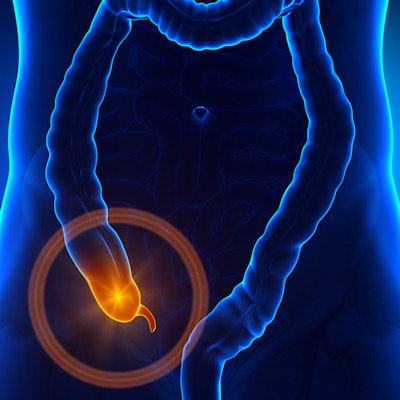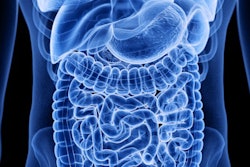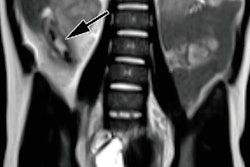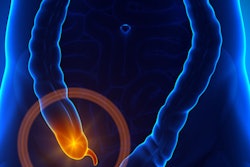
CT has long been the go-to tool for diagnosing appendicitis in kids, but concerns about radiation have radiologists exploring other modalities. Whether MRI could be one of these alternatives was the subject of a study published in the October issue of the American Journal of Roentgenology.
The diagnostic accuracy of MRI and CT is nearly equivalent in the case of acute appendicitis, with no statistically significant difference between them, wrote Dr. Sonja Kinner and colleagues from the University of Wisconsin-Madison.
"Each imaging modality has its own benefits and drawbacks," they wrote. "Contrast-enhanced CT and contrast-enhanced MRI require IV access, whereas an unenhanced MRI can be performed without this burden, which can be beneficial in an already anguished pediatric patient."
Changing the norm
CT is, by a long shot, the most widely used imaging modality to diagnose appendicitis in the U.S., and with good reason: Its use has reduced the number of unnecessary abdominal surgeries by as much as 90% (AJR, October 2017, Vol. 209:4, pp. 911-919).
Still, the growing unease surrounding CT radiation exposure, especially when children are involved, has been swaying physicians to favor other imaging techniques. Ultrasound has received the most attention because of its high availability and low cost. However, the variability in its image quality due to differences in sonographers' abilities, as well as the challenge of convincing young patients to lie still, makes it less than ideal, according to the authors.
The researchers thus decided to determine the accuracy and viability of one alternative to CT -- MRI -- for diagnostic imaging of appendicitis. They prospectively evaluated 48 young patients between the ages of 12 and 20 years who were sent for imaging by the emergency department because of suspected appendicitis.
Based on standard protocol, CT was performed on each of the patients. Only those who were 18 years or older received an intravenous injection of oral contrast. Within two hours of CT scanning, MRI was also performed on each the patients participating in the study.
Three academic abdominal radiologists and three pediatric radiologists independently reviewed all of the resulting CT and MR images. The researchers specifically decided to recruit both academic and pediatric radiologists in order to compare differences in their interpretations; prior research has indicated that additional, previously unidentified injuries were found when pediatric abdominal CT scans for trauma were reinterpreted by pediatric radiologists, they explained.
The radiologists rated the likelihood of acute appendicitis in each case and also reported their interpretation time. Another two radiologists and an emergency physician reviewed all of the data to establish a reference standard.
Imaging parity
With a sensitivity of 93.6% and a specificity of 94.3%, both contrast-enhanced CT and contrast-enhanced MRI demonstrated corresponding accuracy in diagnosing acute appendicitis in young patients. Unenhanced MRI produced marginally lower percentages.
| Accuracy of MRI vs. CT for diagnosing pediatric appendicitis | |||
| Contrast-enhanced CT | Contrast-enhanced MRI | Unenhanced MRI | |
| Sensitivity | 93.6% | 93.6% | 85.9% |
| Specificity | 94.3% | 94.3% | 93.8% |
| Positive predictive value | 85.9% | 85.9% | 83.8% |
There was no statistically significant difference in sensitivity and specificity among contrast-enhanced CT, unenhanced MRI, and contrast-enhanced MRI, according to the authors. In addition, the area under the curve (AUC) was 0.97 for CT, 0.93 for unenhanced MRI, and 0.94 for contrast-enhanced MRI, showing no statistically significant difference among them.
The researchers also found that the diagnostic accuracy and interpretation times of pediatric radiologists and abdominal radiologists were about the same, despite the hypothesis that pediatric radiologists would be more precise. The only substantial difference between them was in their diagnostic accuracy using contrast-enhanced MRI, for which the abdominal radiologists scored higher.
To a small degree, the pediatric radiologists more accurately interpreted unenhanced MR images than the abdominal radiologists. This outcome may be tied to pediatricians' greater experience and comfort examining unenhanced MRI, the authors wrote.
The researchers acknowledged a number of limitations to their study, the most prominent being the small sample size of cases examined. Moreover, a relevant bracket of patients (children younger than 12 years) was not included in the study to avoid having to sedate the children for the MRI scans.
Though various other comparisons can be made -- including the observation that interrater reliability was highest by a slight margin for CT -- the nearly identical diagnostic accuracy among the different imaging modalities outshines them all.
And it brings radiologists back to the original question: What is the best standard of care for children presenting with appendicitis?
CT is typically more accessible and affordable than MRI, but the preoccupation of exposing children to ionizing radiation remains. And this factor may trump all others in the end.
"MRI (unenhanced or contrast-enhanced) ... is often not as readily available as CT, but CT carries the burden of radiation exposure," the authors wrote. "Therefore, we believe that these advantages and disadvantages favor MRI, especially unenhanced MRI."




















